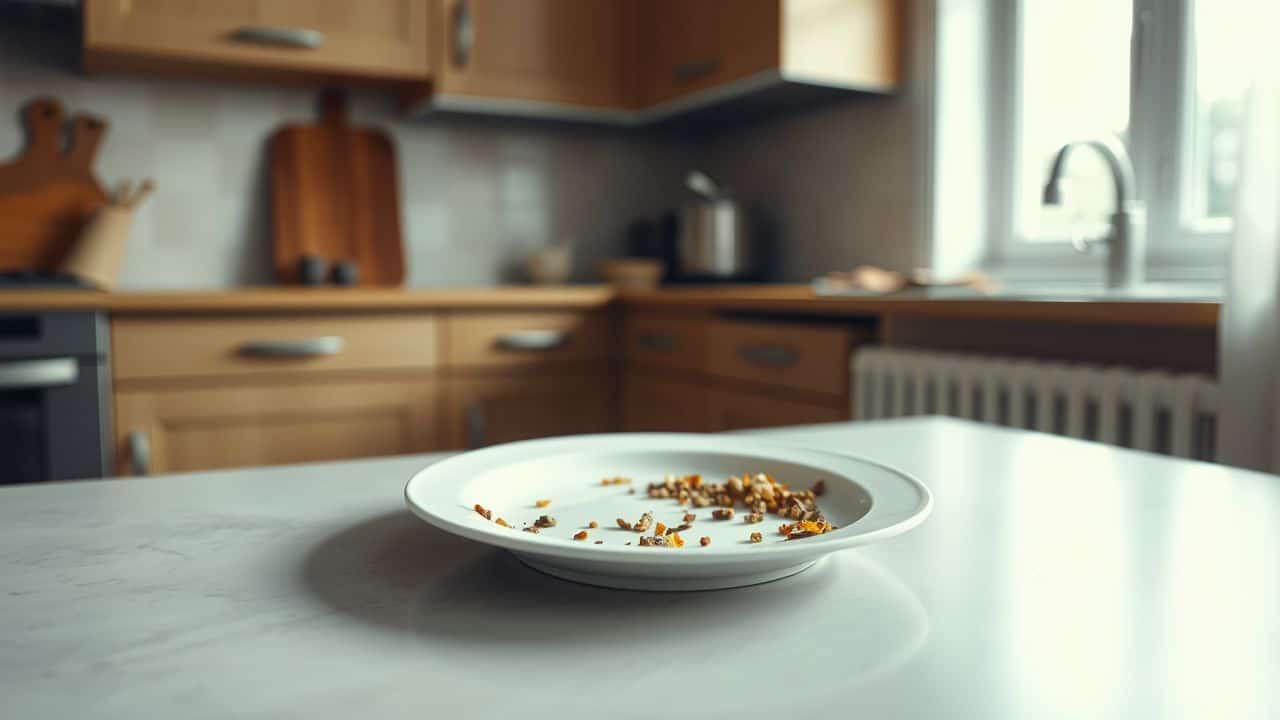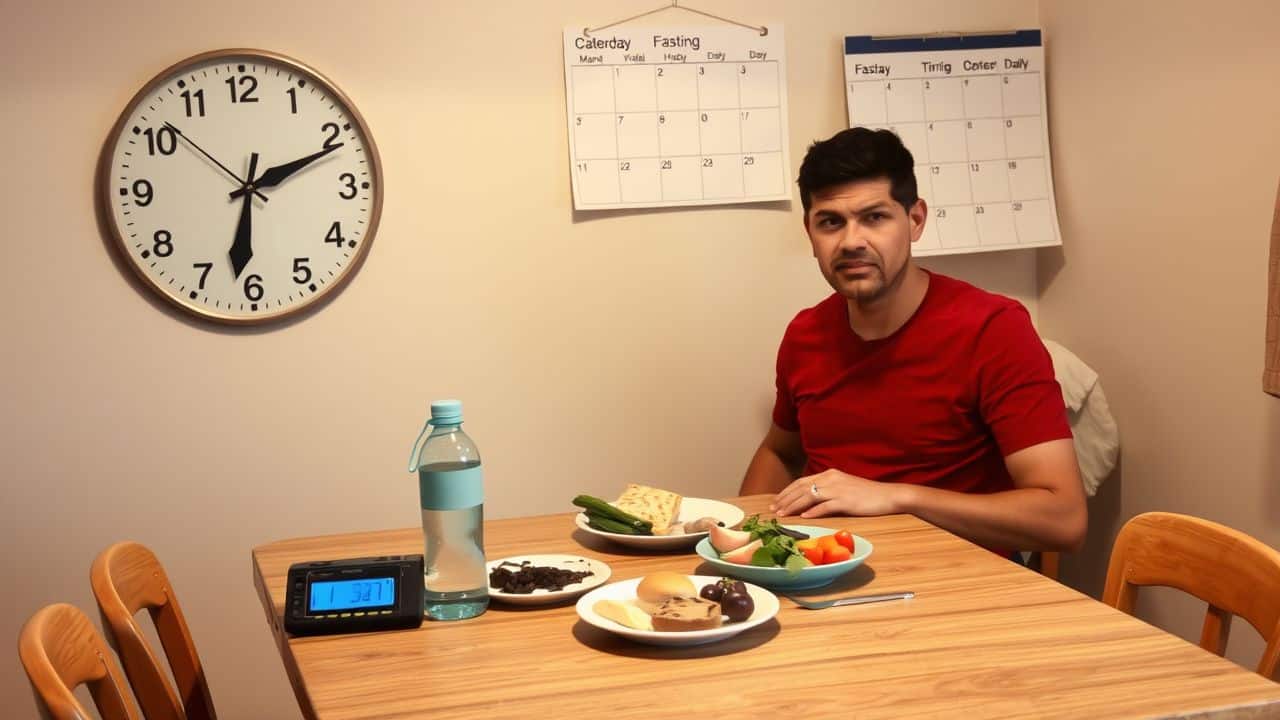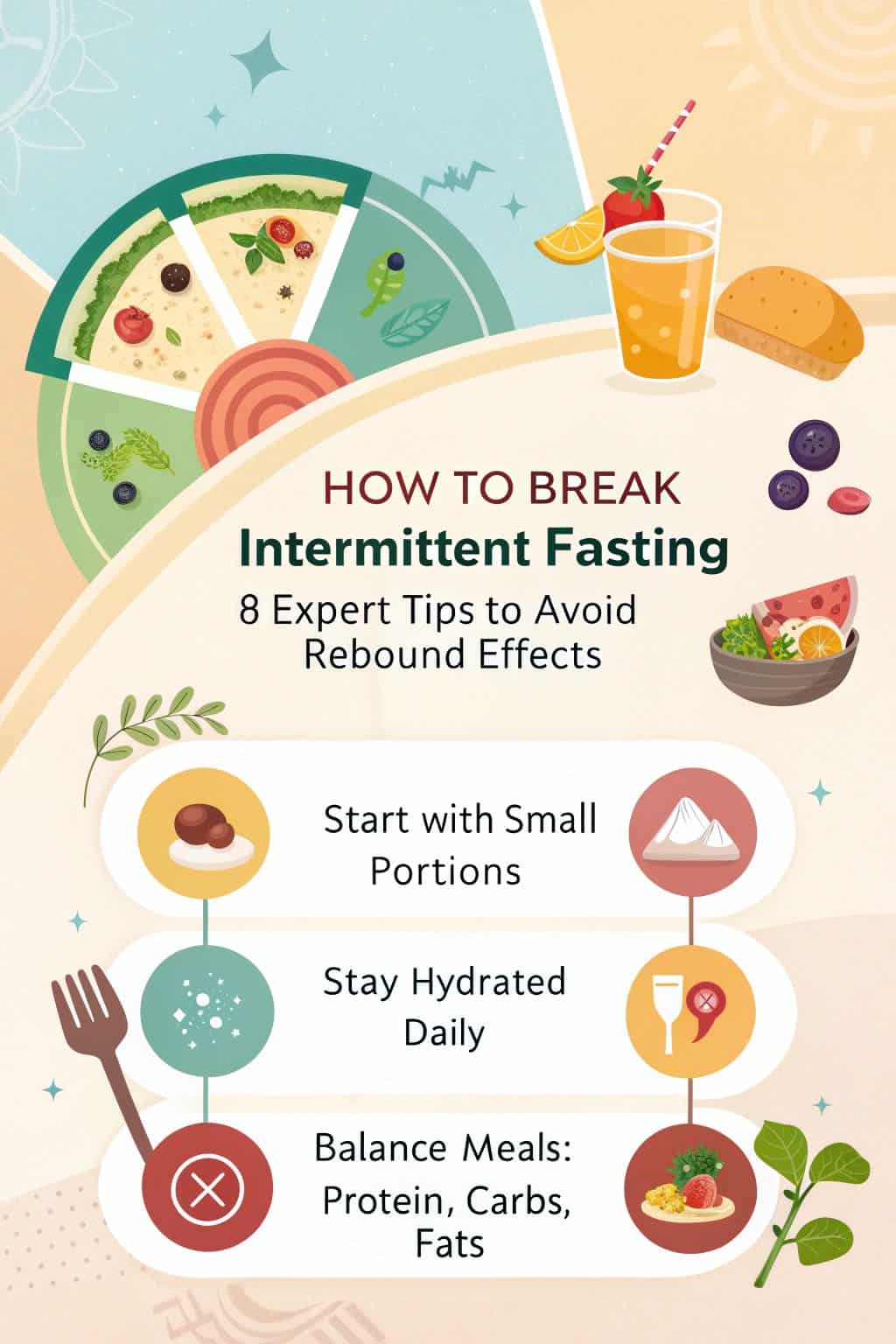Breaking an intermittent fast can be tricky. Many folks worry about undoing their hard work. Did you know that how you end your fast matters just as much as the fast itself? This article will give you eight expert tips to break your fast right.
Ready to learn the smart way to eat after fasting?
Key Takeaways
Break your fast slowly with small portions of easy-to-digest foods like bone broth, fermented foods, and cooked veggies.
Stay hydrated by drinking about 2 liters of water daily during and after fasting.
Avoid sugary, greasy, or processed foods when ending a fast to prevent stomach upset and blood sugar spikes.
Balance your meals with 20-30% protein, 40-50% complex carbs, and 30-40% healthy fats from whole food sources.
Space out 3-4 smaller meals over an 8-hour eating window when breaking a 16/8 intermittent fast to maintain benefits.
Table of Contents
Exploring Intermittent Fasting

Intermittent fasting isn’t just skipping meals. It’s a way of eating that cycles between periods of eating and not eating. This method has gained popularity for its potential health perks and weight loss benefits.
What is Intermittent Fasting and Its Variants
 Intermittent fasting isn’t a diet – it’s a timing trick. You pick set hours to eat and fast. It’s like giving your body a break from food. The most common type is the 16/8 method. You eat for 8 hours and fast for 16.
Intermittent fasting isn’t a diet – it’s a timing trick. You pick set hours to eat and fast. It’s like giving your body a break from food. The most common type is the 16/8 method. You eat for 8 hours and fast for 16.
Some folks do 18:6 or 14:10 instead. It’s flexible, so you can find what works for you.
There are other ways to do it too. The 5:2 plan has you eat normally 5 days a week and cut calories way down for 2. Eat-Stop-Eat involves a full 24-hour fast once or twice a week. These methods can help with weight loss and health.

But they’re not for everyone. It’s smart to chat with a doc before trying an intermittent fasting app or plan. I’ve tried 16/8 myself and found it pretty easy after the first week.
Intermittent fasting is not about what you eat, but when you eat.
Advantages of Practicing Intermittent Fasting

Intermittent fasting packs a punch for health perks. It’s not just about shedding pounds – though that’s a big draw for many guys. This eating pattern can sharpen your mind and boost heart health.
Plus, it kicks your digestion into high gear and adjusts hormones to help burn fat and build muscle. Talk about a win-win!
But there’s more. IF revs up your metabolism and gets your cells working overtime on repair jobs. It’s like giving your body a tune-up from the inside out. And for those worried about blood sugar, the 16:8 plan might help prevent type 2 diabetes.
As a bonus, it can reduce inflammation and make your body more responsive to insulin. Oh, and did I mention it might boost your testosterone and appetite? That’s right – IF could be your secret weapon for overall health and vitality.
Prepare to End Your Fast

Ready to wrap up your fast? Let’s get you prepped! Your body’s about to shift gears, so it’s key to listen up and plan smart.
Recognize Your Body’s Signals

Your body talks to you. Listen up! It’ll tell you when to stop fasting. Hunger pangs, low energy, or mood swings are clear signs. Don’t ignore them. These signals mean your body needs fuel.
Pay attention to how you feel. If you’re cranky or can’t focus, it’s time to eat.
Gut feelings matter too. Rumbling stomachs aren’t the only clue. Watch for headaches or dizziness. These might mean your blood sugar is low. Trust your instincts. If something feels off, break your fast.
It’s better to end early than push too hard. Your body knows best – respect its wisdom.
Plan Your Initial Meal

Now that you’ve tuned into your body’s signals, it’s time to plan your first meal. Crafting a smart post-fast meal can make or break your fasting efforts. Here’s how to do it right:
- Start small: Kick off with a high-protein snack. Think a hard-boiled egg or a handful of nuts.
- Focus on quality: For short fasts (12–24 hours), pick nutrient-dense foods. Lean meats, fish, or legumes are solid choices.
- Go slow: If you’ve fasted over 36 hours, ease back into eating. Your gut needs time to wake up.
- Hydrate wisely: Don’t forget to drink water. Add a pinch of salt for electrolytes.
- Watch portions: After a long fast, your body makes fewer digestive enzymes. Smaller servings are key.
- Chew thoroughly: Eat slowly and stop at 75% full. This helps prevent overeating.
- Balance your plate: Include healthy fats, complex carbs, and proteins. This mix keeps blood sugar steady.
- Avoid problem foods: Skip sugary drinks, alcohol, and hard-to-digest items like raw veggies or dried fruits.
- Time it right: Plan your meal for when you’re alert and relaxed. Avoid eating right before bed.
- Prep in advance: Having a meal ready reduces the chance of grabbing junk food in hunger.
Ending a Short Fast Correctly

Ready to break your short fast? It’s easier than you think. Let’s dive into some smart moves that’ll keep your body happy and avoid any post-fast blues.
Ideal Foods for a Gentle Fast Break

Breaking your fast gently is key to avoiding digestive issues. Here’s a list of ideal foods to ease back into eating:
- Bone broth: This nutrient-rich liquid is easy on the stomach and packed with electrolytes. It helps hydrate and replenish your body after fasting.
- Fermented foods: Kefir, yogurt, and pickled veggies are great for gut health. They provide good bacteria to aid digestion as you start eating again.
- Cooked vegetables: Steamed or roasted veggies are gentle on your system. They offer fiber and nutrients without overwhelming your digestive tract.
- Smoothies: Blend fruits, leafy greens, and a protein source for a balanced meal. This liquid form is easier to digest than solid foods.
- Dried fruits: A small handful can provide quick energy and natural sugars. They’re a good way to ease into eating without spiking blood sugar levels.
- Soups: Light, broth-based soups with soft veggies are easy to digest. They help you stay hydrated while providing essential nutrients.
- Nut butters: A spoonful of almond or peanut butter offers healthy fats and protein. It’s filling without being too heavy on your stomach.
- Low-glycemic fruits: Berries, apples, or pears are good choices. They provide natural sugars and fiber without causing a big glucose response.
Now, let’s talk about how to end a long fast correctly.
Importance of Staying Hydrated
Staying hydrated is key when you’re fasting. Your body needs water to function well, even when you’re not eating. Aim for eight 8-ounce glasses of water daily. That’s about 2 liters.
But don’t sweat it if you drink a bit less or more. Everyone’s different.
Water helps your body in many ways during a fast. It keeps your energy up and helps you feel full. Plus, it’s a great way to tell if you’re really hungry or just thirsty. I once thought I was starving during a fast, but after a big glass of water, the feeling went away.
It’s amazing how often thirst masquerades as hunger!
Water is the driving force of all nature. – Leonardo da Vinci
Guidelines for Ending a Long Fast

Ending a long fast needs care. You can’t just dive into a big meal – that’s asking for trouble.
Introduce Foods Slowly
Slow food reintroduction is key after fasting. Your body needs time to adjust, so take it easy and follow these tips:
- Start small: Begin with a light snack or small meal. A handful of nuts or a piece of fruit can wake up your digestion gently.
- Soup it up: Warm broth or veggie soup is easy on the stomach. It hydrates and provides nutrients without overloading your system.
- Go for soft foods: Cooked veggies, yogurt, or eggs are good choices. They’re nutrient-rich but won’t shock your digestive system.
- Avoid heavy meals: Skip the burger and fries. Heavy, fatty foods can cause bloating and discomfort after a fast.
- Space it out: Eat small amounts every few hours. This helps keep blood sugar stable and prevents overeating.
- Chew thoroughly: Take your time and chew each bite well. It aids digestion and helps you feel full faster.
- Listen to your body: Stop eating when you’re about 75% full. Overeating can lead to stomach upset and nausea.
- Stay hydrated: Drink water between meals. It supports digestion and helps flush out toxins.
Control Portion Sizes
Guys, let’s talk portion control. It’s key when breaking a fast. Your eyes might be bigger than your stomach, but resist the urge to pile your plate high. Aim to feel about 75% full – not stuffed like a Thanksgiving turkey.
This helps dodge bloating and keeps your gut happy. Plus, it’s a smart move for weight management.
Here’s a pro tip: spread your food intake over several small meals instead of one big feast. Think of it as fueling up throughout the day rather than filling the tank all at once. This approach gives your body time to adjust and process nutrients better.
It’s like easing back into the gym after a break – you don’t go all out on day one, right? Same idea with food after fasting. Take it slow, and your body will thank you.
Foods to Avoid When Ending a Long Fast
Ending a long fast needs care. Some foods can upset your stomach or mess with your blood sugar. Here’s what to skip:
- Sugary stuff: Donuts, candy, or soda can make your blood sugar spike. This might leave you feeling jittery or sick.
- Greasy grub: Burgers, fries, or pizza are hard to digest. They can cause stomach pain or the runs.
- Dairy products: If you’re lactose intolerant, milk or cheese can be tough. They might lead to bloating or gas.
- High-fat nuts: Almonds or walnuts are healthy, but not right after a fast. Their fat content can be hard on your gut.
- White bread or pasta: These quick carbs can make your blood sugar jump. You might feel tired soon after.
- Spicy foods: Hot sauce or curry can irritate your empty stomach. This could cause heartburn or acid reflux.
- Alcohol: Beer or wine can hit you hard on an empty stomach. Plus, they’re dehydrating and may make you feel worse.
- Processed snacks: Chips or crackers lack nutrients your body needs. They won’t help you refuel properly.
Now, let’s look at what you should eat to break your fast the right way.
Special Considerations and Precautions

Breaking a fast isn’t always smooth sailing. Some folks might face tricky health issues – like refeeding syndrome or blood sugar swings. It’s smart to chat with a doc before you wrap up your fast, especially if you’ve got any ongoing health stuff.
Understanding Refeeding Syndrome: Risks and How to Prevent Them
Refeeding syndrome can hit hard after a long fast. It happens when your body gets shocked by sudden food intake. Your electrolytes go haywire, especially phosphate, magnesium, and potassium.
This can lead to muscle weakness, trouble breathing, and even seizures. In extreme cases, organ failure is possible. It’s no joke – this condition can be fatal if not handled right.
Breaking a fast is like waking a sleeping giant. Do it gently, or face the consequences.
Prevention is key here, guys. If you’ve lost a lot of weight or have been starving yourself, be extra careful. Same goes for those with eating disorders or chronic health issues. Start slow when you break your fast.
Eat small portions and focus on nutrient-rich foods. Keep an eye on how you feel. If something seems off, don’t tough it out – get medical help. Regular check-ups can also help catch potential problems early.
Next up, let’s talk about tweaking your approach if you have specific dietary needs or health concerns.
Modifying for Dietary Restrictions or Health Issues
Refeeding syndrome isn’t the only hurdle when ending a fast. Folks with special diets or health issues need extra care. Got celiac disease? Steer clear of gluten-packed foods when you break your fast.
Dealing with diabetes? Keep an eye on your blood sugar levels as you ease back into eating. It’s smart to chat with your doc before starting any fasting plan if you’ve got health concerns.
Your body might react differently to certain foods after fasting. Some guys find dairy tough to handle at first. Others might get an upset stomach from high-fiber foods. Listen to your gut – literally! Start with small portions of easy-to-digest foods.
Then slowly add in your usual fare. This way, you’ll avoid nasty surprises and keep your tummy happy.
Meal Plans After Fasting

After fasting, your body craves good fuel. Smart meal plans can help you bounce back and keep the benefits rolling. They’ll guide you on what to eat, when to eat, and how much to put on your plate.
Balance Macronutrients Effectively
Balancing macronutrients is key after intermittent fasting. Here’s how to do it right, guys:
- Protein power: Aim for 20-30% of your calories from protein. Lean meats, fish, eggs, or plant-based options like beans and lentils are great choices. They’ll help rebuild muscle and keep you full.
- Carb control: Stick to 40-50% of calories from complex carbs. Whole grains, sweet potatoes, and fruits give you energy without spiking blood sugar. They’re your friends for steady energy release.
- Healthy fats: Get 30-40% of calories from good fats. Avocados, nuts, seeds, and olive oil support hormone function and keep you satisfied. Don’t fear fat – it’s crucial for your body.
- Veggie variety: Load up on non-starchy veggies. They’re low in calories but high in nutrients. Spinach, broccoli, and bell peppers are solid picks. They’ll keep your gut happy and boost overall health.
- Timing matters: Spread your macros across your eating window. Don’t cram everything into one meal. This helps maintain steady energy and prevents overeating.
- Hydration helper: Water isn’t a macro, but it’s vital. Drink plenty throughout your eating window. It aids digestion and keeps you feeling full.
- Listen to your body: Pay attention to how different macro ratios make you feel. Some guys do better with more carbs, others with more fat. Adjust as needed.
- Quality counts: Choose whole foods over processed ones. They pack more nutrients and keep you fuller longer. Your body will thank you for the real deal.
Focus on Whole Foods
Whole foods are your best pals when breaking a fast. They’re packed with good stuff your body craves. Think fresh fruits, veggies, whole grains, and lean meats. These foods help you feel full and keep your energy up.
They’re also great for your gut health. I’ve found that eating whole foods after fasting makes me feel amazing. My energy lasts longer, and I don’t get those nasty sugar crashes.
Mixing up your whole foods is key. It helps you get all the nutrients you need. Try a colorful salad with grilled chicken, or a bowl of oatmeal topped with berries. These meals are tasty and good for you.
They’ll help you stay on track with your health goals. Plus, they’re easy to make. Next up, let’s talk about some common mistakes to avoid when ending your fast.
Schedule and Frequency of Meals After Fasting
After fasting, it’s crucial to plan your meals wisely. Let’s dive into some tips for scheduling and spacing out your food intake:
- Start small: Begin with a light meal or snack. This helps your body ease back into digestion.
- Space it out: Aim for 3-4 smaller meals instead of 1-2 large ones. This prevents overloading your system.
- Time it right: Eat your first meal within 1–2 hours of ending your fast. This kickstarts your metabolism.
- Listen to your body: Pay attention to hunger cues. Don’t force food if you’re not hungry yet.
- Stick to a window: Keep your eating within an 8-hour period if following the 16/8 method. This maintains the benefits of fasting.
- Gradual increase: Slowly up your food intake over a few days. This helps avoid digestive issues like loose stools.
- Stay consistent: Try to eat at similar times each day. This helps regulate your circadian cycle and insulin sensitivity.
- Adjust as needed: If you’re new to fasting, start with 1–2 days a week. Increase frequency as your body adapts.
Typical Errors to Avoid

Typical errors when breaking a fast can trip you up. Watch out for these pitfalls! They might just derail your progress… Ready to learn more? Let’s dive in!
Avoid Overeating
Guys, let’s chat about easing back into eating after a fast. It’s tempting to go all out, but that’s not the way to go. Your body needs to adjust gradually. Begin with smaller portions and take your time eating.
This helps your stomach get back into its groove. Plus, it lets you savor your food instead of inhaling it.
Choosing the right foods is crucial. Opt for protein-rich, fiber-packed options. They’ll satisfy you without making you feel bloated. And hey, don’t skimp on water! Sometimes we think we’re hungry when we’re actually thirsty.
Skip the fizzy drinks, though. They can mess with your hunger signals. If you’re antsy to move, stick to gentle exercise. Intense workouts right after fasting? Not the best plan. Keep in mind, taking care of yourself after fasting is essential for your body’s well-being.
Do Not Compromise on Nutritional Quality
Don’t skimp on food quality after fasting. Your body needs good fuel to bounce back. Lean proteins and fiber-rich eats are your best friends here. They’ll keep you full and stop those annoying hunger spikes.
Skip the junk food – it’ll only leave you wanting more. Instead, go for nutrient-dense options. Think colorful veggies, whole grains, and lean meats. These foods pack a punch of vitamins and minerals your body craves.
Hydration is important too, guys. Avoid the sugary drinks and stick to good old H2O. Or try some hydrating foods like cucumbers or watermelon. Your body will thank you. Keep in mind, extreme calorie cuts are a bad idea.
They’ll just lead to rebound eating and mess with your nutrition. Aim for balance instead. It’s about giving your body what it needs to thrive. This way, you’ll keep your energy up and your weight-loss goals on track.
Avoid Rushing Your Eating Process
Slow down, guys! Rushing through meals can mess up your fasting efforts. Eating too fast tricks your brain into thinking you’re still hungry. This leads to overeating and undoes all your hard work.
Take your time, chew slowly, and savor each bite. This helps your body recognize when it’s full.
Don’t gulp down your food like it’s a race. Your digestive system needs time to work its magic. Eating slowly lets your body absorb nutrients better. It also helps prevent that bloated feeling after meals.
Plus, you’ll enjoy your food more when you’re not inhaling it. So, put down the fork between bites and chat with your buddies. Your body will thank you for it.
People Also Ask
What’s the best way to break an intermittent fast?
Start slow, champ. Go for easy-to-digest foods like yogurt or high-fiber fruits. These help your tummy wake up gently. Don’t dive into a feast right away. Your body needs time to rev up its digestive engines.
Can I drink coffee when breaking my fast?
You bet! Coffee’s fine, but skip the sugar. Non-caloric sweeteners are okay too. Just remember, coffee might make your tummy grumble if it’s empty. Maybe pair it with a small snack to keep things smooth.
How does breaking a fast affect blood sugar?
It’s like waking a sleeping bear. Your blood glucose levels might spike if you’re not careful. This is extra important for folks with diabetes or prediabetes. Stick to low-carb options at first to keep your glucose response in check.
Are there risks to breaking a fast incorrectly?
You bet. Going overboard can lead to tummy troubles like diarrhea or feeling bloated. In rare cases, it might even mess with your electrolytes. Take it easy, and you’ll be fine.
How does alcohol impact breaking a fast?
Whoa there, partner! Alcohol on an empty stomach is a recipe for disaster. It can lead to nasty stuff like alcoholic ketoacidosis. Plus, it might make you more likely to binge-eat. Best to wait until you’ve had some solid food.
Can breaking a fast affect my medications?
Good question! Some meds, like levothyroxine, work best on an empty stomach. Others need food. Chat with your doc about the best time to take your pills when you’re doing time-restricted eating. They’ll help you stay on track.
References
https://www.healthline.com/nutrition/intermittent-fasting-guide
https://www.medicalnewstoday.com/articles/322293
https://science.drinklmnt.com/fasting/how-to-break-an-intermittent-fast/
https://www.healthline.com/nutrition/what-breaks-a-fast
https://www.healthline.com/nutrition/how-to-fast
https://www.medicalnewstoday.com/articles/327398
https://www.signos.com/blog/how-to-break-a-fast
https://my.clevelandclinic.org/health/diseases/23228-refeeding-syndrome
https://www.ncbi.nlm.nih.gov/books/NBK564513/
https://www.youtube.com/watch?v=2LEWKoHPDmE&pp=ygUMI3Bvc3RmYXN0aW5n
https://www.healthline.com/nutrition/16-8-intermittent-fasting
https://pmc.ncbi.nlm.nih.gov/articles/PMC6520689/
https://www.eatingwell.com/article/7676144/mistakes-you-can-make-while-intermittent-fasting/

